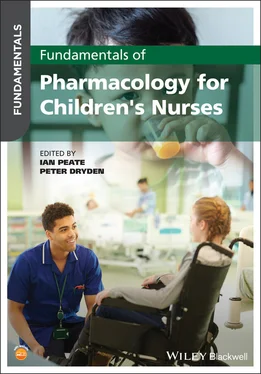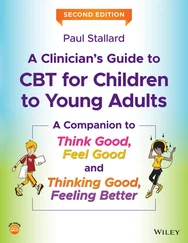1 Cover
2 Title Page
3 Copyright Page
4 Dedication Page
5 Contributors
6 Preface Terminology References
7 Acknowledgements
8 Prefixes and Suffixes
9 Abbreviations
10 About the Companion Website
11 1 Introduction to Pharmacology, Children and Young People Introduction to Pharmacology Professional Framework The Importance and Value of Medicine Within Healthcare Therapeutic Pharmacology Social Prescribing Safety Within Paediatric Care Medicines Optimisation Medicines Medicine Management Safety: Rights of Medication Administration Specific Considerations for Babies, Children and Young People Infancy Adolescents Tablets Distraction Techniques Conclusion References Further Resources Multiple Choice Questions Find Out More
12 2 How to Use Pharmaceutical and Prescribing Reference Guides Introduction The British National Formulary and the British National Formulary for Children Paper Copy BNFc How to navigate the BNFc Online and Mobile Application BNFc Monthly Index of Medical Specialities (MIMS) Electronic Medicines Compendium What Can Be Prescribed on an NHS Prescription? Other Guides to Prescribing The Evidence Base to Prescribing: Prescribing Guidelines Conclusion References Further Resources Multiple Choice Questions
13 3 Legal and Ethical Issues Introduction The Law The Bolam Test The Children Act 2004 Duty of Care and Healthcare Regulation of Healthcare Ethical Principles and Theories Research Children and Young People who are under 16 years – Gillick and Fraser Guidance Assessing and Promoting Competence Parental Responsibility Medication Adherence and Administration Conclusion References Further Resources Multiple Choice Questions Find Out More
14 4 Medicines Management and the Role of the Healthcare Provider Working with Children, Young People and Families Introduction Being an Accountable Professional Nursing and Midwifery Council Employer and Colleagues Promoting Health and Preventing Ill Health Holistic Assessment Assessing Needs and Planning Care Self‐Medication Complementary and Alternative Medication (CAM) Planning Providing and Evaluating Care Checking Evaluation Leading and Managing Nursing Care and Working in Teams Improving Safety and Quality Coordinating Care Conclusion References Further Resources Multiple Choice Questions Find Out More
15 5 Pharmacodynamics and Pharmacokinetics Introduction Royal Pharmaceutical Society The Nursing and Midwifery Council Pharmacokinetics Think Paediatrics Pharmacodynamics Conclusion References Further Resources Multiple Choice Questions
16 6 Drug Formulations Introduction Licensing of Paediatric Medicines Types of Formulations Excipients Enteral Feeding Tubes Displacement Values Conclusion Glossary References Further Resources Multiple Choice Questions Find Out More
17 7 Medications Used in the Cardiovascular System Introduction Gross Anatomy Related to Cardiovascular System (CVS) Pharmacology Cardiovascular Drugs Affecting Chronic Conditions Anticoagulant Medications Angiotensin Converting Enzyme (ACE) Inhibitors Angiotensin II Receptor Antagonists Peripheral Alpha Antagonist or Alpha‐Adrenergic Blockers: ‘Alpha Blockers’ Cardiovascular Drugs for Use in Acute Clinical Scenarios Electrophysiological System Recap Drugs with an Inotropic Effect Drugs with a Chronotropic Effect Conclusion Glossary References Further Resources Multiple Choice Questions Find Out More
18 8 Medications Used in theRenal System Introduction Anatomy and Physiology of the Renal System Common Renal Conditions Nephrotic Syndrome Treatment of MCNS Drugs Used to Treat Electrolyte Disorders Conclusion Glossary References Further Resources Multiple Choice Questions Find Out More
19 9 Medications Used in the Endocrine System Introduction The Endocrine System Medications Used in Endocrine Disorders Affecting Growth Endocrine Disorders of Puberty Drugs Used to Block Puberty or the Action of Sex Steroids Drugs Used to Reduce the Action of Sex Steroids Medications Used in Disorders of the Adrenal Glands Medications Used in the Management of Diabetes Conclusion References Further Resources Multiple Choice Questions Find Out More
20 10 Medications Used in the Respiratory System Introduction Asthma Croup Bronchiolitis Pneumonia Cystic Fibrosis Respiratory Medicines Antibiotics Mucolytics Other Respiratory Drugs Conclusion Glossary References Further Resources Multiple Choice Questions Find Out More
21 11 Medications Used in the Gastrointestinal System Introduction Overview of the Anatomy and Physiology of the Gastrointestinal System The Stomach Small Intestines The Liver The Gallbladder The Pancreas The Large Intestine Gastro‐Oesophageal Reflux Disease (GORD) Enteral Feeding Tubes and Medication Administration Constipation Crohn’s Disease Conclusion Glossary References Further Resources Multiple Choice Questions Find Out More
22 12 Medications Used in the Nervous System Introduction Epilepsy Guillain–Barré Syndrome Migraine Status Migrainosus Conclusion References Further Resources Multiple Choice Questions Appendix 1: AEDs Used in Treatment of Childhood Epilepsy
23 13 The Immune System and Immunisations Introduction Types of Immunity How Immunisations Work Immunisation and Public Health Immunisation Schedule Vaccine Uptake The ‘Cold Chain’ Patient Specific Directions and Patient Group Directives Administration of Vaccines Common Reactions and Anaphylaxis Communication with the Child and Family The Green Book Conclusion Glossary References Further Resources Multiple Choice Questions Find Out More
24 14 Medications and the Integumentary System Introduction Anatomy and Physiology of the Integumentary System The Epidermis Common Skin Conditions Conclusion References Further Resources Multiple Choice Questions Find Out More
25 15 Medications Used in Children and Young People’s Mental Health Introduction What Is Psychopharmacology? Medications Conclusion References Further Resources Multiple Choice Questions Find Out More
26 16 Medications Used in Children and Young People’s cancer Introduction Cancer Cell Cycle Chemotherapies Immunotherapies in Treating Cancer Corticosteroid Use in Cancer Conclusion Glossary References Further Resources Multiple Choice Questions Find Out More
27 17 Analgesics Introduction Pain Pathways Definitions and Categories of Pain Importance of Individualised Pain Assessments Assessment Tools Multimodal Management Strategies Pharmacological Management Non‐opioids Non‐Steroidal Anti‐Inflammatory Drugs (NAIDs) Opioid Agonists Codeine Phosphate Dihydrocodeine Tramadol Morphine Fentanyl Adjuvants and Co‐analgesics – Gabapentinoids Inhalation Analgesics Local, Regional and Topical Analgesia Conclusion References Further Resources Multiple Choice Questions Find Out More
28 18 Antimicrobial Medications Introduction Microorganisms Antimicrobial Medications Antibacterial Medications Penicillins Antiviral Medications Antifungal Medications Antiprotozoal Medications Antimicrobial Resistance Antimicrobial Stewardship Prescribing Antimicrobials Conclusion Glossary References Further Resources Multiple Choice Questions Find Out More
29 19 Adverse Drug Reactions Introduction Adverse Events Side Effects Preventing ADRs Recognising ADRs ADRs and Immunisations Allergic Reactions Anaphylaxis Medicines Safety and Reporting ADRs Reporting ADRs via The Yellow Card System Conclusion References Further Resources Multiple Choice Questions
30 Answers
31 Index
32 End User License Agreement
1 Chapter 1 Table 1.1 Pharmacokinetics and pharmacodynamics. Table 1.2 Medicine administration, preservation of safety.
2 Chapter 2 Table 2.1 Text format and information purpose. Table 2.2 Abbreviations of medication categories. Table 2.3 Examples of local and national prescribing guidelines.
Читать дальше











